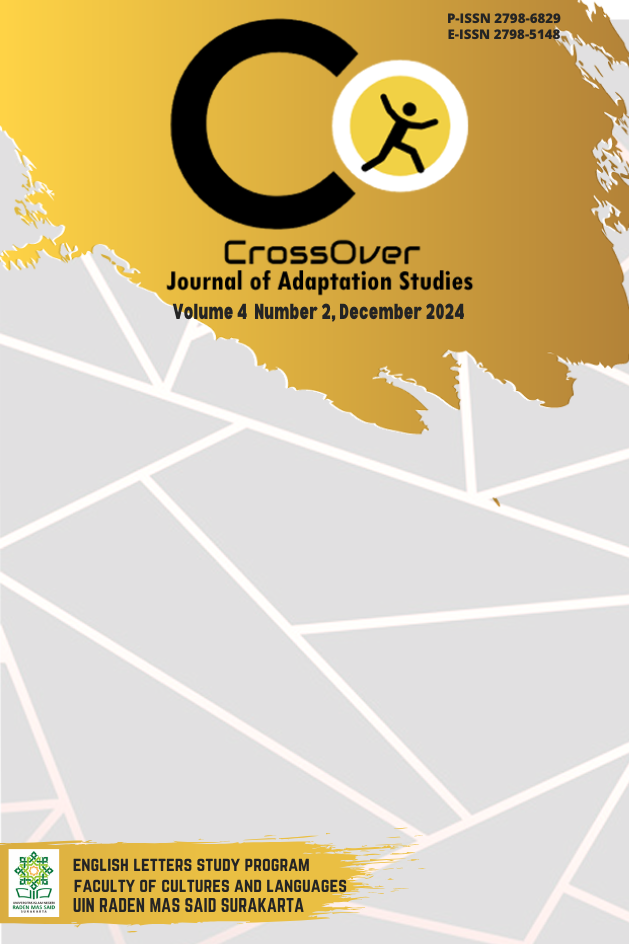BEYOND THE SCREEN: THE RETCONNING OF BLACK CHARACTERS IN POPULAR CULTURE MOVIES THROUGH THE LENS OF BLACKWASHING
DOI:
https://doi.org/10.22515/crossover.v4i2.9356Keywords:
retroactive continuity, blackwashing, quantitative transformation, adaptationAbstract
The portrayal and adaptation of characters in movies often reflect societal norms and values, with "blackwashing" emerging as a significant phenomenon. Blackwashing refers to casting black actors in roles traditionally portrayed by white characters, often as part of efforts to promote representation and address historical inequalities. This study explores the types of retroactive continuity (retcon) found in black characters within popular culture films through the perspective of blackwashing. The research employs Hutcheon’s (2013) adaptation theory, which conceptualizes adaptation as creative reinterpretation rather than mere replication, alongside Friedenthal’s (2017) retcon framework and Genette’s (1997) qualitative transformation theory for supplementary analysis. Using a qualitative approach, the study applies the documentation method for data collection and Spradley’s (2016) analysis technique. Seven adapted films (hypertexts) are compared to their original works (hypotexts), revealing three distinct types of retcon: reinterpretation, reinscription, and revision. These findings demonstrate how adaptation practices not only reshape narratives but also challenge traditional representations to align with evolving social values. The findings highlight how adaptation practices reshape narratives to address historical inequalities and enrich representation in media. This research contributes to the understanding of blackwashing as a tool for inclusivity and social progress in film adaptation. Future studies are recommended to explore blackwashing across diverse cultural contexts and genres to deepen insights into its impact on global representation and audience reception.
Downloads
References
Bateman, J. A., & Veloso, F. O. (2013). The semiotic resources of comics in movie adaptation: Ang Lee’s Hulk (2003) as a case study. Studies in Comics, 4(1), 135–157. https://doi.org/10.1386/stic.4.1.135_1
Bowen, T. M. (2021). Toward a new classics: A de- and reconstruction of the classics in the classroom and beyond. Senior Projects Spring 2021, 176. Retrieved from https://digitalcommons.bard.edu/senproj_s2021/176
Friedenthal, A. J. (2017). Retcon game: Retroactive continuity and the hyperlinking of America. University Press of Mississippi.
Corbett-Browne, C. (2024). Spider-Man: The character with many faces. Regis University Student Publications (Comprehensive Collection), 1118. Retrieved from https://epublications.regis.edu/theses/1118
Genette, G., & Prieto, C. F. (1989). Palimpsestos (pp. 118–125). Taurus.
Genette, G. (1997). Palimpsests: Literature in the second degree (Vol. 8). University of Nebraska Press.
Hutcheon, L., & O’Flynn, S. (2013). A theory of adaptation (2nd ed.). Routledge.
Hutcheon, L. (2006). A theory of adaptation. Routledge.
Kinney, M. (2013). A review of Linda Hutcheon’s A theory of adaptation. Critical Voices: The University of Guelph Book Review Project, 3(3), 7–15.
McKinney, A. (2020). Black identity, representation, and identification in comic book movies. XULAneXUS, 20(2), Article 1. Retrieved from https://digitalcommons.xula.edu/xulanexus/vol20/iss2/1
Nurhalidasia, N., Tami, R., & Nasrum, N. (2016). The character alteration of Maleficent from Sleeping Beauty into Maleficent movie. Jurnal Adabiyah, 16(2), 138–148.
Parveen, J. J. (2018). Adaptation as an adaptation: A study of the movie Adaptation. International Journal of English: Literature, Language & Skills, 6(4). https://www.ijells.com/wp-content/uploads/2018/02/January-2018.pdf#page=52
Proctor, W. (2023). A new terminology? Discourses, distinctions, definitions. In Reboot culture (pp. 1–18). Palgrave Macmillan. https://doi.org/10.1007/978-3-031-40912-7_2
Simonet, G. (2010). The concept of adaptation: Interdisciplinary scope and involvement in climate change. SAPI EN. S. Surveys and Perspectives Integrating Environment and Society, 3(1). https://doi.org/10.13140/RG.2.1.2772.4403
Smith, A. M. (2021). Whitewashing v. blackwashing: Structural racism and anti-racist praxis in Hollywood cinema (Senior Independent Study Theses, Paper 9455). The College of Wooster. https://digitalcommons.wooster.edu/independentstudy/9455
Summers, S. (2019). Adapting a retro comic aesthetic with Spider-Man: Into the Spider-Verse. Adaptation, 12(2), 190–194. https://doi.org/10.1093/adaptation/apz014
Wardani, L. D. P., Rifqiyah, F., & Kusumayanti, D. D. (2021). Transformations in A Little Princess movie: An adaptation analysis. Jurnalistrendi: Jurnal Linguistik, Sastra, dan Pendidikan, 6(2), 117–128.
Welang, N. (2018). Triple consciousness: The reimagination of Black female identities in contemporary American culture. Open Cultural Studies, 2(1), 296–306. https://doi.org/10.1515/culture-2018-0030
Worlds, M. (2019). Miles Morales: Spider-Man and reimagining the canon for racial justice. English Journal, 108(4), 43–50.
Downloads
Published
How to Cite
Issue
Section
Citation Check
License
Copyright (c) 2024 Lu'lu'a Lu'lu'a, Muhammad Fikri Asysyamil, Ahsan Zain, Dzulfikar Hanif, Gerry Ros, Rizky Viko Pratama

This work is licensed under a Creative Commons Attribution-ShareAlike 4.0 International License.
Authors retain copyright and grant the journal right of first publication with the work simultaneously licensed under a Creative Commons Attribution 4.0 International License that allows others to share the work with an acknowledgment of the work's authorship and initial publication in this journal.

















